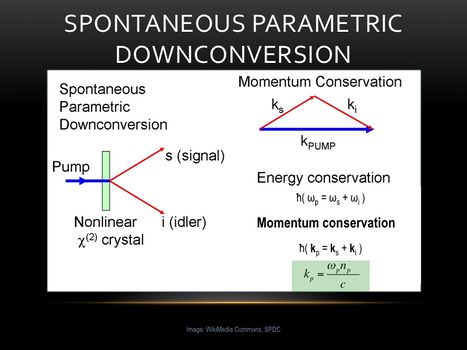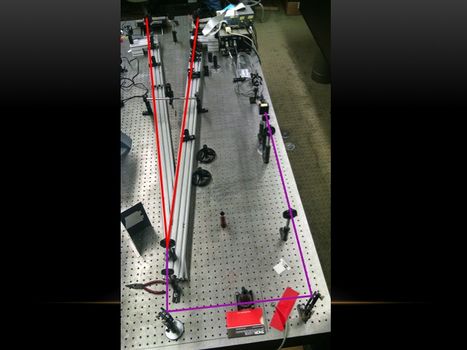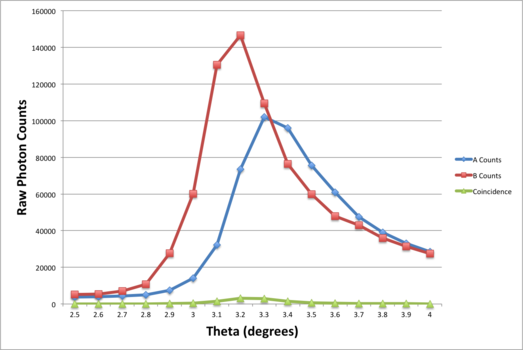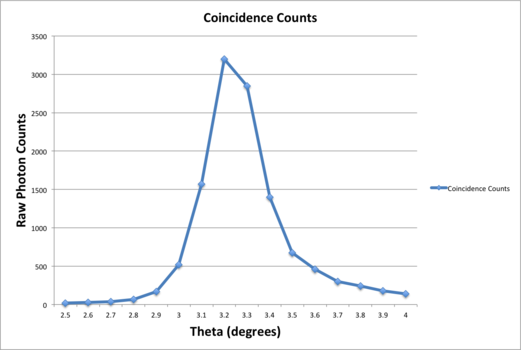Spontaneous Parametric Downconversion
Contents
Quantum Optics and Spontaneous Parametric Downconversion
The goal of this project is to use a series of table-top laser-based optics experiments to investigate various quantum mechanical phenomena. These include, but are not limited to: quantization of the electric field (proof of the existence of photons), single-photon interference, violation of Bell inequalities, and quantum information measurements.
Physics Background
Overview
Spontaneous parametric downconversion (SPDC) is a non-linear optical process that takes place with the assistance of specially-engineered optical crystals. These optical crystals are designed with specific index of refraction properties along given crystalline axis. When light of a specific frequency is incident upon the lattice, it will experience preferential absorption and re-emission as a result of this design. This will result in an overall "splitting" of one incident light beam into two beams, a "signal" and an "idler" beam, at some well-defined angle with respect to the optical input axis (serving as the zero). The quanta of light will experience a downconversion but within this the momentum and energy of the beam is conserved in the signal and idler beams. See figure 1 for an illustration, below for a simplified explanation, and the WikiPedia article for maximum detail.[1].
Downconversion
If we reduce the incident beam to a series of single photons, whose existence is a central postulate of quantum theory, the above description need only be slightly altered. A single photon incident on the crystalline lattice has a certain probability of being downconverted via the interaction with the lattice (roughly 1 in 10^12)[2]. When this conversion takes place, the single photon, with its inherent polarization properties, is converted into a pair of polarization entangled photons at half the energy and wavelength. The output pair has the same polarization, but is polarized orthogonal to the input beam. Type II follows the same characteristic downconversion (DC) as the Type I but with one very crucial difference. In Type II downconversion the polarizations of the output beams are now orthogonal to one another (with some overlap in their respective electric fields so that there is a possibility for photon interaction, and unlike that of Type I where there is no possibility for interaction after the downconversion crystal). The way one sets their experiment for Type I or Type II downconversion is by choosing the correct the crystal lattice cut (i.e. purchasing the correct crystal). The lattice will be cut in such a way that the axis with varying indices of refraction will favor one DC type over the other.
Experimental Setup
In our experiment we started with a 405nm blue diode pump laser. We then put the laser through an iris and a linear polarizer to ensure horizontal polarization. Once through the polarizer the laser was then pushed through a half wave plate in order to change the polarization of the beam from horizontal to vertical polarization. After being reflected off of two mirrors the light is incident on the downconversion crystal, producing two 810nm output beams. A beam blocker was placed down the beam path to block any stray 405nm light. The two output beams (signal and idler beam) traveled at an angle of roughly 3 degrees off axis with respect to the input beam. These two beams would then travel down their respective legs and reach a photodetector to record their individual and coincidence counts. See the block diagram as well as the setup photograph.
In setting up the experiment we needed to vary the angle of the legs so that we could verify that the maximum count occurred at approximately 3 degrees (see results below for details). We then installed a 50/50 polarizing beam splitting cube along the signal beam in front of the B detector. We also placed another detector (designated B') the same distance for the crystal but at a 90 degree angle from detector B to match the orientation of the polarizing beam splitter. This concludes the setup for any experiment that can be done involving 3-detector coincidence.
Results
Group 3: Kevin Masson and Alex Schachtner
Maximizing Photon Counts
In order to have the best possible experimental results, we sought to maximize the photon counts at each leg of the experiment. To do this, we varied the angle of each optical leg from 2.5 degrees to 4 degrees by increments of one-tenth of a degree from the central axis. Recorded values of photon counts are shown below. We found that the maximum counts occurred at approximately 3.2 degrees. This matches the theoretical maximum angle for photon counts of 3 degrees.







